AUDI S3 2015 Owners Manual
Manufacturer: AUDI, Model Year: 2015, Model line: S3, Model: AUDI S3 2015Pages: 310, PDF Size: 76.15 MB
Page 151 of 310
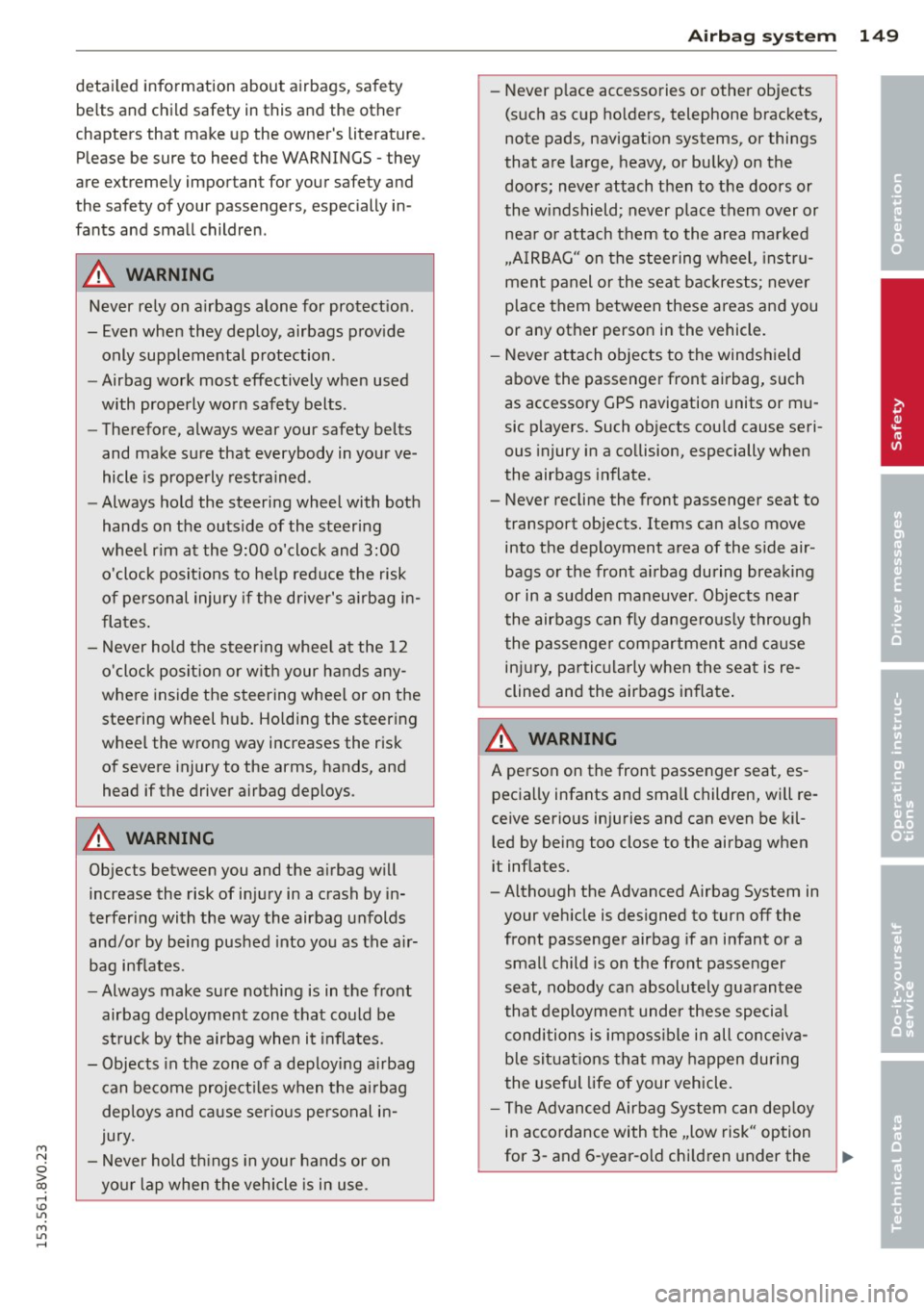
M N
0 > co ,...., \!) ..,.,
M ..,., ,....,
detailed information about airbags, safety
belts and child safety in this and the other
chapters that make up the owner's literature.
Please be sure to heed the WARNINGS -they
are ex tremely important for your safety and
the safety of your passengers, especially in
fants and small children .
A WARNING
Never rely on airbags alone for protection.
- Even when they deploy, airbags provide only supplemental protection .
- Airbag work most effectively when used
with properly worn safety belts .
- Therefore, always wear your safety belts
and make sure that everybody in your ve
hicle is properly restrained .
- Always hold the steering wheel with both
hands on the outside of the steering
wheel rim at the 9:00 o'clock and 3:00
o'clock positions to help reduce the risk
of personal injury if the driver's airbag in
flates.
- Never hold the steering wheel at the 12
o'clock position or with your hands any
where inside the steering wheel or on the
steering wheel hub. Holding the steering
wheel the wrong way increases the risk of severe injury to the arms, hands, and
head if the driver airbag deploys .
A WARNING
Objects between you and the airbag will
increase the risk of injury in a crash by in
terfering with the way the airbag unfolds
and/or by being pushed into you as the air
bag inflates.
- Always make sure nothing is in the front
airbag deployment zone that could be
struck by the airbag when it inflates.
- Objects in the zone of a deploying airbag
can become projectiles when the airbag
deploys and cause serious personal in
jury.
- Never hold things in your hands or on
your lap when the vehicle is in use .
-
Airbag system 149
-Never place accessories or other objects
(such as cup holders, telephone brackets,
note pads, navigation systems, or things
that are large, heavy, or bulky) on the
doors; never attach then to the doors or
the windshield; never place them over or
near or attach them to the area marked
,,AIRBAG " on the steering wheel, instru
ment panel or the seat backrests; never
place them between these areas and you
or any other person in the vehicle.
- Never attach objects to the windshield
above the passenger front airbag, such
as accessory GPS navigation units or mu
sic players. Such objects could cause seri
ous injury in a collision, especially when
the airbags inflate.
- Never recline the front passenger seat to transport objects. Items can also move
into the deployment area of the side air
bags or the front airbag during breaking
or in a sudden maneuver . Objects near
the airbags can fly dangerously through
the passenger compartment and cause
injury, particularly when the seat is re
clined and the airbags inflate.
A WARNING
-=
A person on the front passenger seat , es-
pecially infants and small children, will re
ceive serious injuries and can even be kil
led by being too close to the airbag when
it inflates.
- Although the Advanced Airbag System in your vehicle is designed to turn
off the
front passenger airbag if an infant or a
small child is on the front passenger
seat, nobody can absolutely guarantee
that deployment under these special conditions is impossible in all conceiva
ble situations that may happen during
the useful life of your vehicle.
- The Advanced Airbag System can deploy
in accordance with the ,,low risk" option
for 3-and 6-year-old children under the
•
•
•
Page 152 of 310
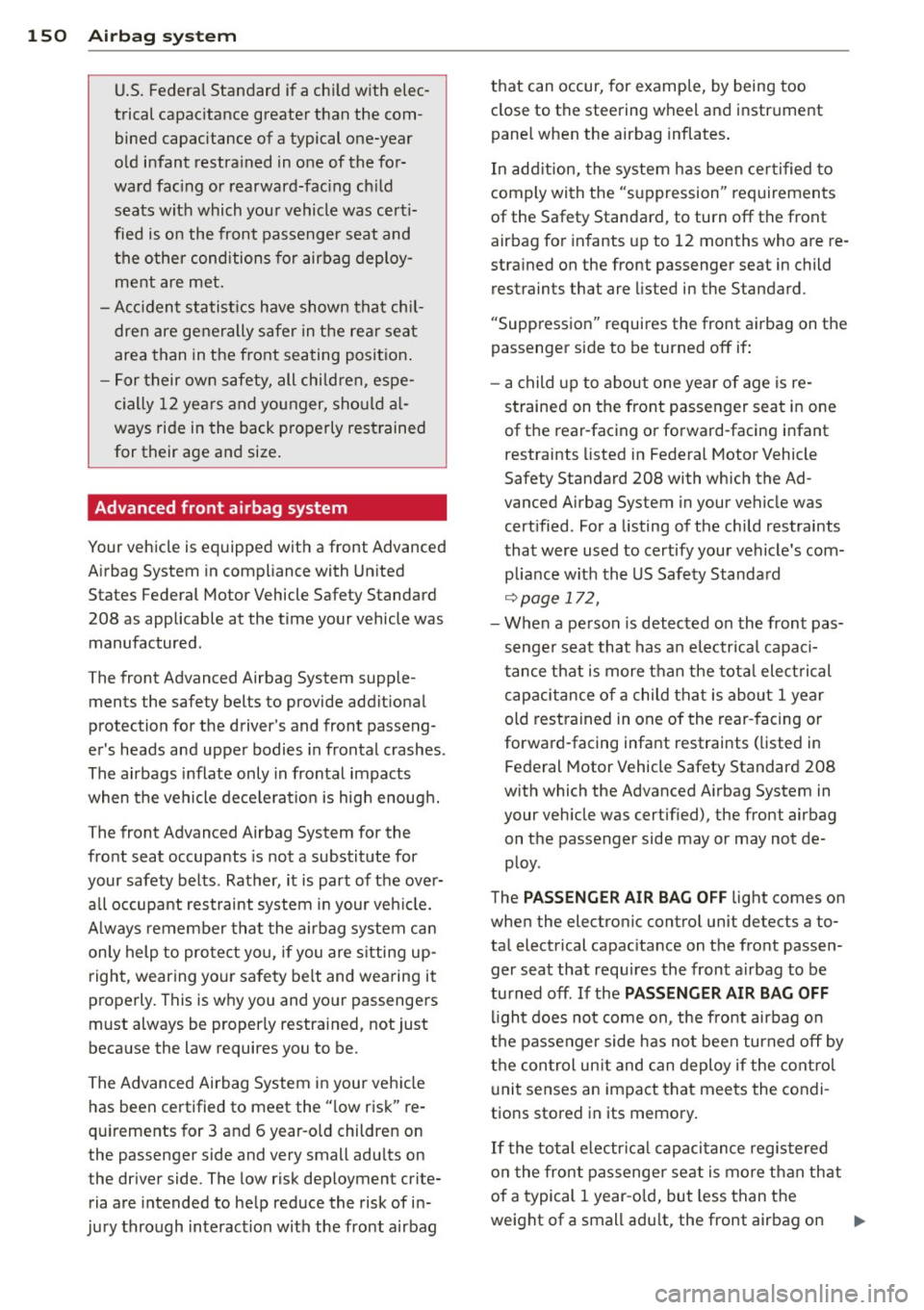
150 Airbag sys te m
U.S. Federal Standard if a chi ld with elec
trical capac itance greater than the com
bined capacitance of a typical one-year
old infant restra ined in one of the for
ward fac ing or rearward-fac ing ch ild
seats with which your vehicle was certi
fied is on the front passenger seat and
the other conditions for airbag deploy ment are met.
- Acc ident statist ics have shown that chil
dren are generally safer in the rear seat
area than in the front seating posit ion .
- For their own safety, all chi ldren, espe
ci ally 12 years and younger, sho uld a l
ways ride in the back properly rest rained
for their age and size .
Advanced front airbag system
Your vehicle is equipped with a front Advanced
Airbag System in compliance with United
States Federal Motor Vehicle Safety Standard
208 as applicable at the time your vehicle was manufactured.
The front Advanced Airbag System supple ments the safety belts to provide addit ional
protection for the driver's and front passeng
er's heads and upper bodies in frontal crashes .
The airbags inflate only in frontal impacts
when the vehicle dece le rat io n is high enoug h.
The front Advanced Airbag System for the
fro nt seat occupants is not a substitute for
your safety belts . Rather, it is part of the over
a ll occupa nt restraint system in your veh icle.
A lways remember that the airbag system ca n
on ly help to pro tect you, if you are s itting up
right, wearing yo ur safety belt and wearing it
properly. This is why you and yo ur passengers
must always be properly restrained, not just
beca use the law requires you to be.
The Advanced Airbag System in your veh icle
has been certified to meet the " low risk" re
qu irements for 3 and 6 year-o ld children on
the passenger side and very small adu lts on
the dr iver side. The low risk deployment crite
ria are intended to he lp reduce the risk of in
jury through interaction with the front airbag that can occur, for example, by being too
close to the steering wheel and instr ument
panel when the airbag inflates .
In add ition, the system has been cer tified to
comply with the "s uppression" requirements
of the Safety Standard, to turn off the front
airbag for infants up to 12 months who are re
stra ined on the front passenger seat in child
restraints that are listed in the Standard.
"Suppression" requires the front airbag on the
passenger side to be turned off if:
- a child up to abo ut one year o f age is re
st rained on the front passenger seat in one
of the rear -facing or fo rward -facing infant
restraints listed in Federal Motor Vehicle
Safety Standard 208 with which the Ad
vanced Airbag System in your vehicle was
cert ified . Fo r a listing of the chi ld restraints
that were used to certify you r vehicle's com
plia nce w ith the US Saf ety Standard
r::) page 172,
- When a person is detected on the front pas
senger seat that has an electrical capaci
tance that is more than the tota l elect rical
capacitance o f a child tha t is about 1 year
old rest rained in one of the rear- facing or
forward-facing infant restraints (listed in Federal Motor Vehicle Safety Standard 208
w ith which the Advanced A irbag System in
your veh icle was certified), the front airbag
on the passenger side may or may not de ploy.
The
PASSENGER AIR BAG OFF light comes on
when the electro nic control unit detects a to
ta l electrical capac itance on the front passen
ger seat that requ ires the front airbag to be
tu rned off. If the
PASSENGER AIR BAG OFF
light does not come on, the fro nt airbag o n
t h e passenger side has not been turned off by
the con trol un it and can deploy if the cont ro l
u nit senses an impact that meets the condi
tions stored in its memo ry .
If the total e lectr ic al c apaci tance regis tered
o n t he fron t passenge r se at is more than that
of a typical 1 year -o ld, but less than the
weight of a small adu lt, the front airbag on
ll-
Page 153 of 310
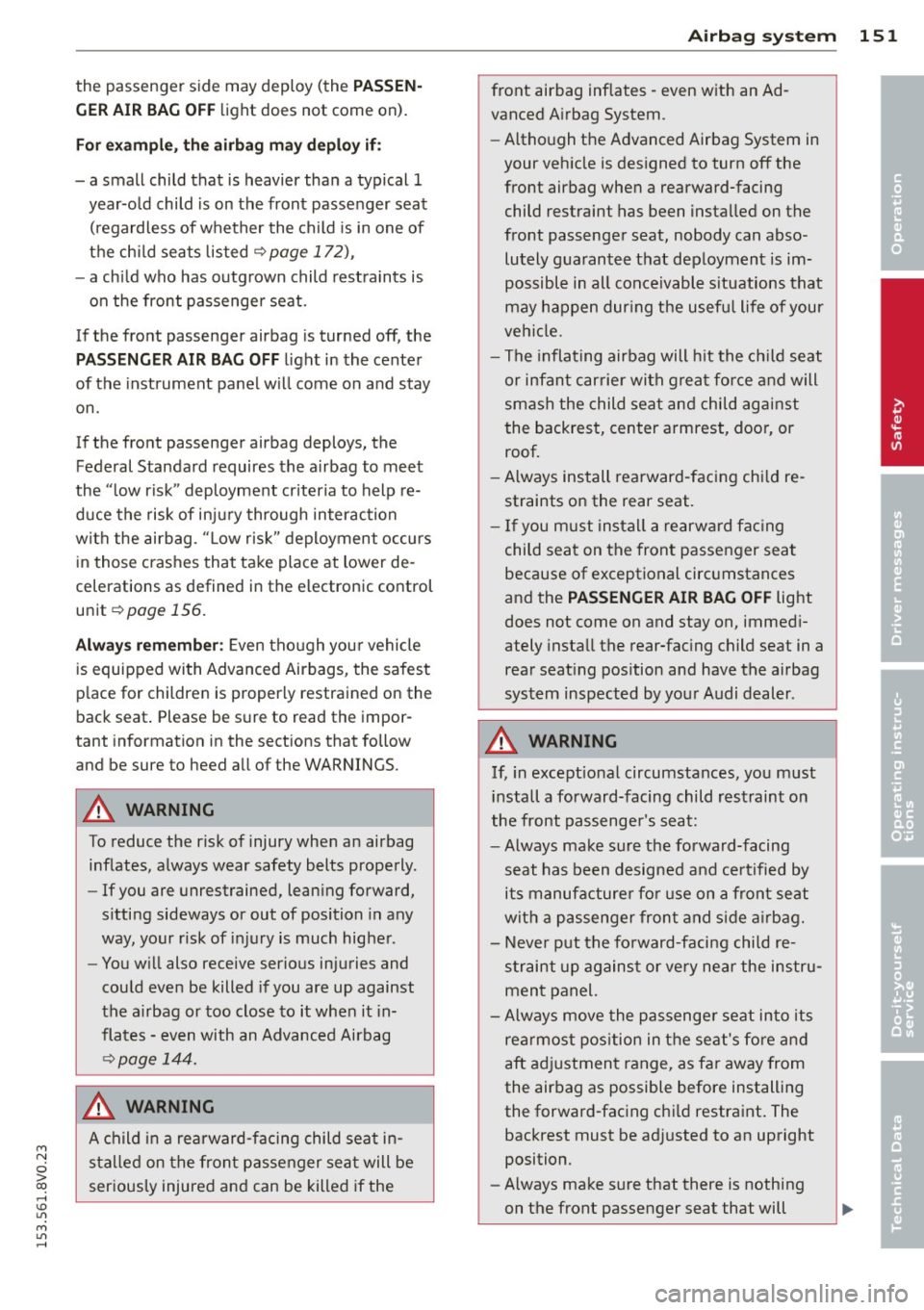
M N
0 > co ,...., \!) ..,.,
M ..,., ,....,
the passenger side may deploy (the PASS EN
GER AIR B AG OFF
light does not come on).
For exa mple, the ai rba g may d epl oy if :
- a small child that is heavier than a typical 1
year-o ld child is on the front passenger seat
(regardless of whether the child is in one of
the ch ild seats listed
¢ page 172),
- a ch ild who has outgrown child restra ints is
on the front passenge r seat.
If the front passenger airbag is turned off, the
P A SSENGER AIR BAG OFF light in the center
of the instrument panel w ill come on and stay
on.
If the front passenger airbag deploys, the
Federal Standard requires the airbag to meet
the "low risk " deployment criteria to help re·
duce the risk of injury through interaction
with the airbag . "Low risk" deployment occurs
in those crashes that take place at lower de
celerations as defined in the electronic control unit
r=> page 156.
Alwa ys r em emb er: E ven tho ugh you r vehicle
is equipped with Advanced Airbags, the safest
p lace for children is properly restrained on the
back seat . Please be sure to read the impor
tant information in the sect ions that follow
and be sure to heed all of the WARNINGS .
A WARNING
To reduce the risk of injury when an airbag
inflates, always wear safety belts properly .
- If you are unrestrained, lean ing forward,
sitting sideways or out of position in any
way, your risk of injury is much higher .
- You w ill also receive serious injuries and
cou ld even be killed if you are up against
the a irbag or too close to it when it in·
flates -even with an Advanced Airbag
r::!v page 144.
A WARNING
A child in a rearward-facing child sea t in
stalled on the front passenger sea t will be
ser iously injured and can be killed if the
-
A irbag system 15 1
front airbag inflates - even with an Ad·
vanced Airbag System .
- Altho ugh the Advanced Airbag System in
your veh icle is designed to turn off the
front airbag when a rearward-facing
child restraint has been installed on the
front passenger seat, nobody can abso
lutely guarantee that deployment is im
possible in all conceivable s ituations that
may happen dur ing the usefu l life of your
veh icle.
- The inflating airbag will h it the ch ild seat
or infant carrier with grea t force and will
smash the child seat and child against
the backrest, center armrest, door, or
roof.
- Always install rearward -facing chi ld re
straints on the rear seat .
- I f you must install a rearward fac ing
child seat on the front passenger seat
because of exceptional circumstances
and the
PASSENG ER AIR BAG O FF light
does not come on and stay on, immed i·
ately install the rear-fac ing child seat in a
rear seat ing pos ition and have the airbag
system inspected by your Audi dealer .
A WARNING
If, in except ional circumstances, you must
install a forward-facing child restraint on
the front passenge r's seat:
- Always make sure the forward-facing
seat has been designed and certified by
its manufacture r fo r u se on a front seat
with a passenger front and s ide a irbag.
- Never put the fo rward-faci ng child re
straint up against or ve ry near the instru
ment panel.
- Always move the passenge r seat into its
rearmost pos ition in the seat's fore and
aft ad justment range, as fa r away from
the airbag as possible before installing
the forward-fac ing chi ld restraint . The
backrest must be adj usted to an upright
position.
- Always make sure that there is nothing
on the front passenger seat that will •
•
•
Page 154 of 310
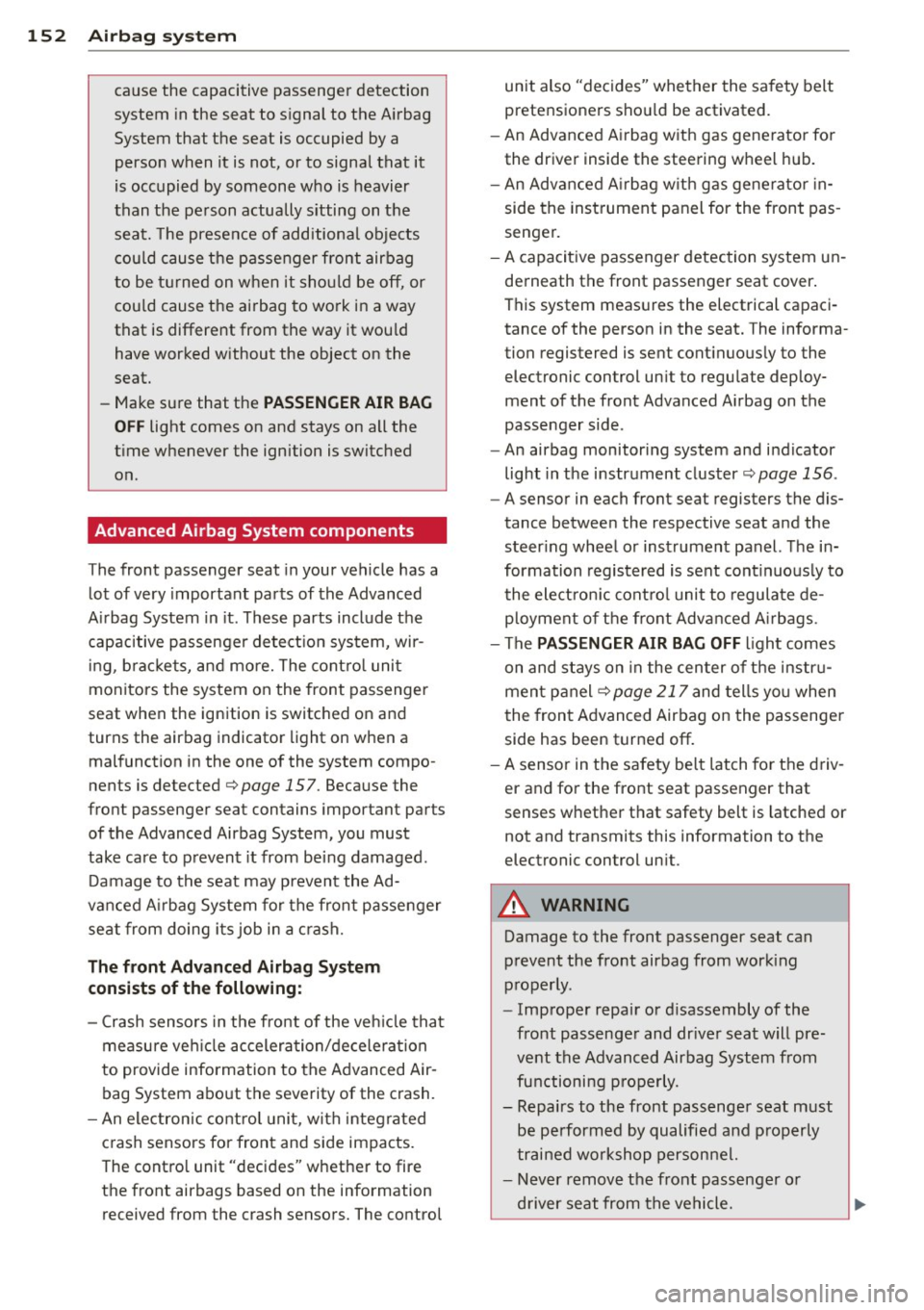
152 Airbag sys te m
cause the capacitive passenger detection
system in the seat to s ignal to the A irbag
System that the seat is occupied by a person when it is not, or to signal that it
is occupied by someone who is heavier
than the person actually s itting on the
seat. The presence of additional objects
cou ld cause the passenger front airbag
to be t urned on when it sho uld be off, or
cou ld cause the airbag to work in a way
that is different from the way it wou ld
have worked without the object on the
seat.
- Make sure that the
PA SSENGER AIR BAG
OFF
light comes on and stays on all the
t ime whenever the ignition is switched
on.
Advanced Airbag System components
The front passenger seat in your vehicle has a
lot of very important parts of the Advanced
A irbag System in it . These parts include the
capacitive passenger de tect ion system, wir
ing, b ra ck ets, and more. The cont ro l unit
monitors the system on the front passenger
seat when the ign ition is switched on and
turns the airbag indicato r light on when a
malfunction in the one of the system compo
nents is detected¢
page 157 . Because the
fro nt passenger seat contains important parts
of the Advanced Airbag System, you must
take care to prevent it from being damaged .
Damage to the seat may prevent the Ad
vanced A irbag System for the front passenger
se at from doing i ts job in a c rash.
The front Advanced Airbag System
consists of the following:
- Crash sensors in the fro nt of the ve hicle that
m easure ve hicle accelera tion/de celera tion
to provide info rmation to the Advanced Air
bag System abo ut the seve rity of the crash.
- An electronic cont ro l u nit, with integrated
c rash sensors for front and side impacts.
The cont ro l unit "decides" whether to fire
the front airbags based on the information received from the crash sensors. The contro l unit also "decides" whether the sa
fety belt
pretensioners sho uld be activated.
- An Advanced A irbag w ith gas generato r for
the driver inside the steering wheel h ub.
- An Advance d Airbag w ith g as generato r in
side the inst rument panel for the front pas
senger.
- A capacit ive passenger detection system un
de rneath the front passenger seat cover .
This system meas ures the electrical capac i
tance of the person in the seat. The informa
tion registered is sent cont inuo usly to the
electronic control un it to regu late deploy
ment of the front Advanced A irbag on the
passe nger side .
- An airbag monitor ing system and indicator
light in the instrument cluster¢
page 156 .
-A sensor in each front seat registers the dis
tance betwee n the respective seat and the
steer ing whee l o r inst rument panel. The in
formation registered is sent cont inuous ly to
t he ele ct ron ic contro l unit to regula te de
p loyment of the front Adva nced A irb ags .
- The
PASSENGER AIR BAG OFF light comes
on and stays on in the center of t he instr u
ment p anel ¢
page 217 and t ells yo u when
the fron t Advanced Airbag on the passenge r
side has been turned off.
- A sensor in the safety be lt latch for the driv
er and for the front seat passenger that
senses whether t hat safety belt is latched or
not and transmits this information to the
electronic control un it.
A WARNING
Damage to the front passenger seat can
prevent the front airbag from wor king
p roperly.
- Improper repair or d isassembly of the
front passenge r and dr iver sea t will pre
vent the Advanced Airbag System from
functioning p roperly.
- Repairs to the front passenge r seat must
be pe rformed by qualified and p roperly
trained workshop personnel.
- Never remov e the front passenger o r
d river seat from the vehicle.
-
Page 155 of 310
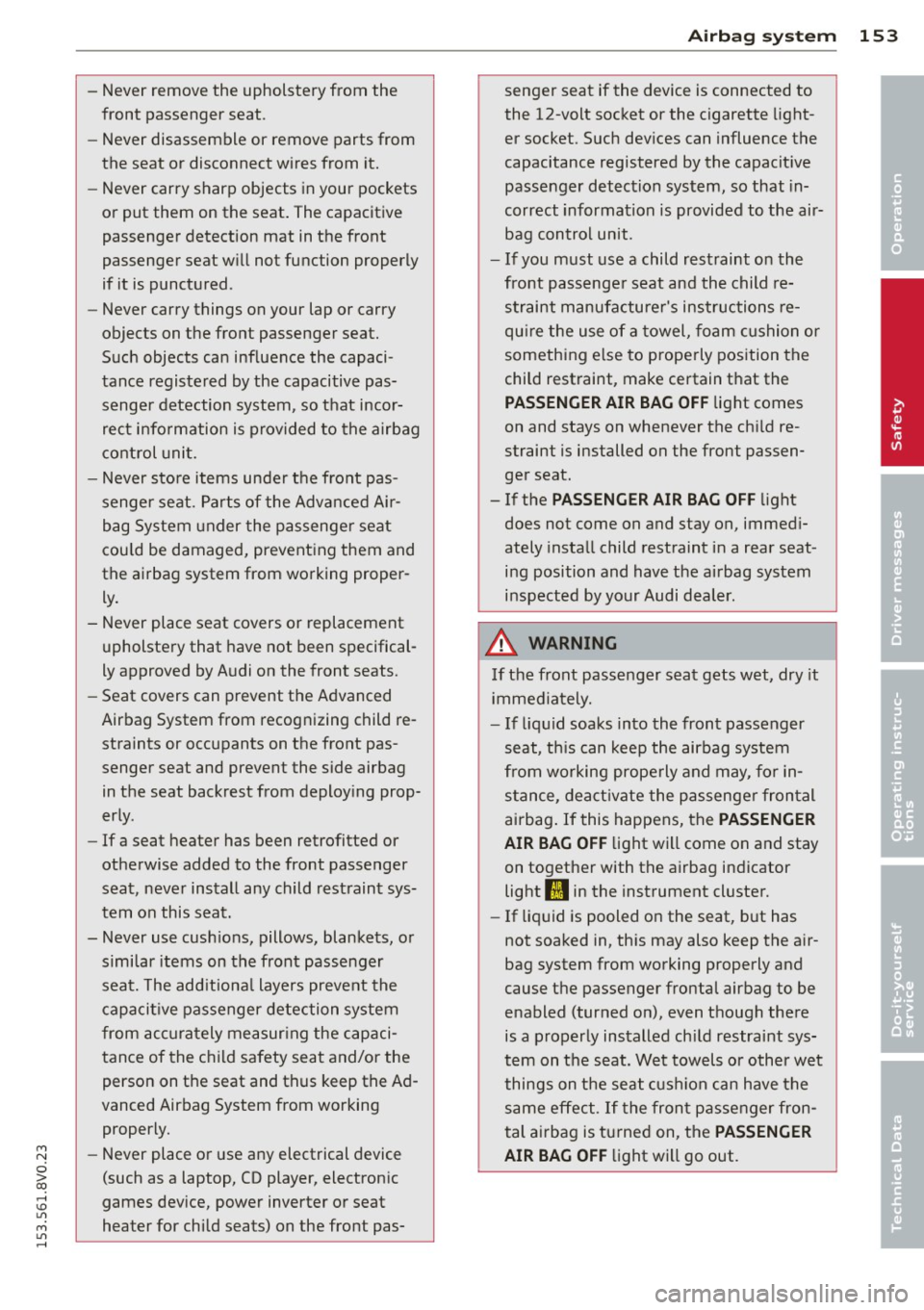
Airbag system 153
-Never remove the upholstery from the senger seat if the device is connected to
front passenger seat . the 12-volt socket or the cigarette light-
- Never disassemble or remove parts from er socket. Such devices can influence the
the seat or disconnect wires from it. capacitance registered by the capacitive
- Never carry sharp objects in your pockets passenger detection system, so that
in-
or put them on the seat. The capacitive correct information is provided to the air-
passenger detection mat in the front bag control unit
.
•
-If you must use a child restraint on the • passenger seat will not function properly
if it is punctured . front passenger seat and the child
re-
- Never carry things on your lap or carry straint manufacturer's instructions
re-
objects on the front passenger seat. quire the use of a
towel, foam cushion or
Such objects can influence the capaci -something else
to properly position the
tance registered by the capacitive pas- child restraint, make certain that the
senger detection system, so that incor-
PASSENGER AIR BAG OFF light comes
rect information is provided to the airbag on and stays on whenever the child re-
control unit. straint is installed on the front passen-
- Never store items under the front pas- ger seat.
senger seat. Parts of the Advanced Air- -
If the
PASSENGER AIR BAG OFF light
bag System under the passenger seat does not come on and stay on, immedi-
could be damaged, preventing them and ately
install child restraint in a rear seat -
the airbag system from working proper- ing position and have the airbag system
ly. inspected by your Audi dealer
.
- Never place seat covers or replacement
A WARNING upholstery that have not been specifical-
ly approved by Audi on the front seats.
If the front passenger seat gets wet, dry it
- Seat covers can prevent the Advanced
immediately.
Airbag System from recognizing child re- -If liquid soaks into the front passenger
straints or occupants on the front pas-
seat, this can keep the airbag system
senger seat and prevent the side airbag from working properly and may, for in-
in the seat backrest from deploying prop- stance, deactivate the passenger frontal
erly .
airbag. If this happens, the
PASSENGER
-If a seat heater has been retrofitted or AIR BAG OFF light will come on and stay
otherwise added to the front passenger on together with the airbag indicator
seat, never install any child restraint sys-
light
fl in the instrument cluster.
tern on this seat. -If liquid is pooled on the seat, but has
- Never use cushions, pillows, blankets, or
not soaked in, this may also keep the air-
similar items on the front passenger bag system from working properly and
seat. The additional layers prevent the cause the passenger frontal airbag to be
capacitive passenger detection system
enabled (turned on), even though there
from accurately measuring the capaci-
is a properly installed child restraint sys-
tance of the child safety seat and/or the
tern on the seat. Wet towels or other wet
person on the seat and thus keep the Ad- things on the seat cushion can have the
vanced Airbag System from working same effect.
If the front passenger fron-
properly. tal airbag is turned on, the
PASSENGER
M -Never place or use any electrical device AIR BAG OFF light will go out. • N
0 > (such as a laptop, CD player, electronic co ,...., games device, power inverter or seat \!) 1.1"1
M
heater for child seats) on the front pas-1.1"1 ,....,
Page 156 of 310
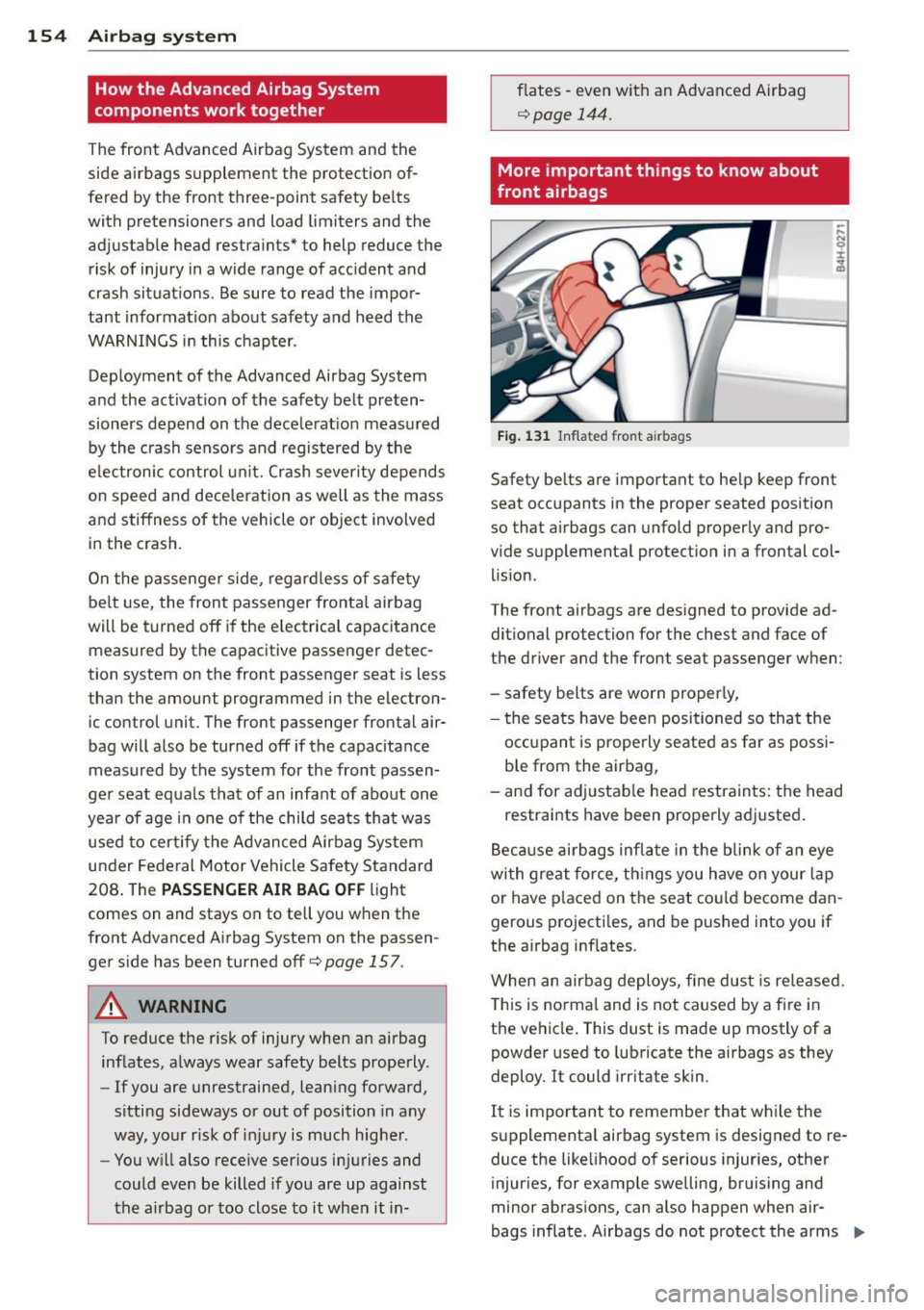
154 Airbag system
How the Advanced Airbag System
components work together
The front Advanced Airbag System and the
side airbags supplement the protection of
fered by the front three-point saf ety be lts
with pretensioners and load limiters and the
adjus table head restr aints* to help reduce the
risk of injury in a wide range of acc ident and
crash situat ions. Be sure to read the impor
tant information about safety and heed the
WARNINGS in this chapter .
Deployment of the Advanced Airbag System
and the activat ion of the safety belt preten
sioners depend on the decelerat ion measured
by the crash senso rs and regis tered by the
e lectronic control u nit. Crash sever ity depends
on speed and deceleration as well as the mass
and stiffness of the vehicle or object involved
in the crash.
On the passenger side, regard less of safety
be lt use, the front passenger fronta l airbag
will be turned off i f the e lectrical capac itance
measured by the capacitive passenger detec
tion system on the front passenge r seat is less
than the amount programmed in the electron ic control unit. The front passenger frontal air
bag will also be turned off if the capacitance
measured by the system for the front passen
ge r seat equa ls that of an infant of abo ut one
yea r of age i n one of the child sea ts that was
used to cer tify the Advanced Airbag System
under Federal Motor Vehicle Safety Standard
208 . The
PASSENGER AIR BAG OF F light
comes on and stays on to tell you when the
front Advanced A irbag System on the passen
ger s ide has been turned off¢
page 157.
A WARNING
To reduce the risk of injury when a n airbag
inflates, a lways wear safety belts properly .
- If you are unrestrained, leaning forward,
sitting sideways or out of position in any
way, your risk of inj ury is much higher.
- You wi ll also receive serious injuries and
could even be killed if you are up against
the a irbag or too close to it when it in- flates
-even w ith an Advanced A irbag
¢ page 144.
More important things to know about
front airbags
Fi g. 1 31 Inflated f ro nt a irba gs
-...
q :r:
iZ
Safety be lts are important to he lp keep front
seat occupants in the proper seated position
so that a irbags can unfold proper ly and pro
vide supplemental protect ion in a frontal col
lis ion .
The front airbags are designed to provide ad ditional protection for the chest and face of
the driver and the front seat passenger when :
- safety belts are worn proper ly,
- the seats have been positioned so that the
occupant is properly seated as far as poss i
b le from the airbag ,
- and for ad justab le head restraints : the head
restraints have been properly adj usted .
Bec ause airbags inflate in the bli nk of an eye
with great force, th ings you have on your lap
or have p laced on the seat co uld become dan
gerous pro jecti les, and be p ushed into you if
the a irbag inf lates .
When an airbag deploys, fine dust is re leased.
T his is no rma l and is not caused by a fi re in
the vehicle . This dust is made up mostly of a
powder used to lubricate the airbags as they
deploy . It could irr itate skin .
It is important to remembe r that while the
supplementa l airbag system is designed to re
duce the like lihood of serious injur ies, other
injur ies, for examp le swelling, bruising and
minor abrasions, can also happen when air-
bags inflate . A irbags do not protect the arms
IIJI,
Page 157 of 310
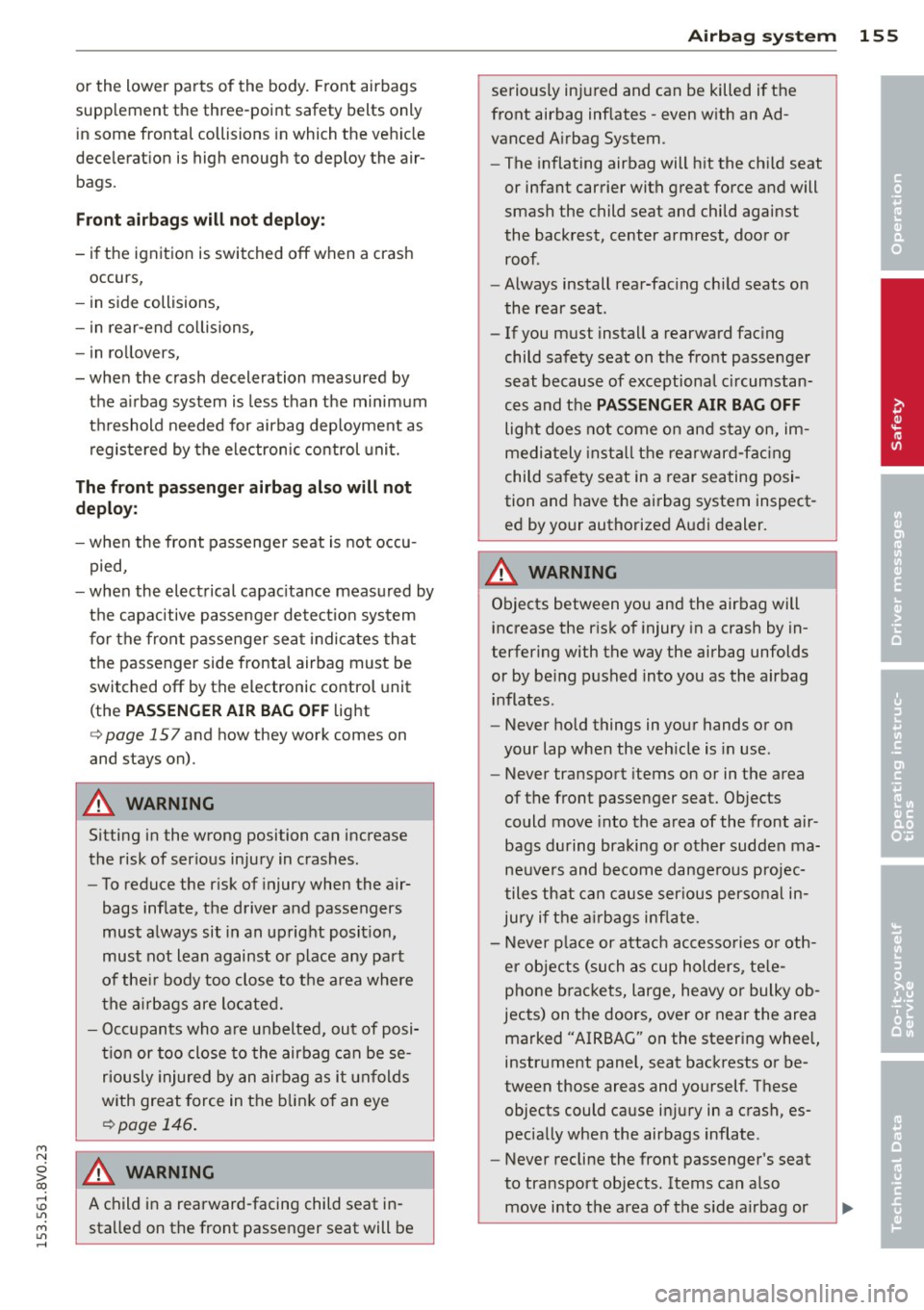
M N
0 > co ,...., \!) 1.1'1
M 1.1'1 ,....,
or the lower parts of the body. Front airbags
supp lement the three-point safety belts only
in some frontal collisions in which the vehicle
dece leration is high enough to deploy the air
bags.
F ront airbag s will no t deplo y:
- if the ignition is switched off when a crash
occurs,
- in side collisions,
- in rear-end collisions,
- in rollovers,
- when the crash deceleration measured by
the a irbag system is less than the m inimum
threshold needed for airbag deployment as
registered by the electronic control unit.
The f ront pas seng er airbag al so will n ot
deploy:
- when the front passenger seat is not occu
pied,
- when the electrical capac itance measured by
the capacitive passenger detect io n system
for the front passenger seat indicates that
the passenger side frontal airbag must be
switched off by the electronic control unit
(the
P AS SENGER A IR BA G OFF light
Q page 157 and how they work comes on
and stays on).
A WARNING
Sitting in the wrong position can increase
the risk of serious injury in crashes.
- To reduce the r isk of injury when the air
bags inflate, the driver and passengers
must always sit in an upright posit ion,
must not lean against or place any part
of the ir body too close to the area where
the a irbags are located.
- Occupants who a re unbelted, out of posi
t ion or too close to the airbag can be se
riously injured by an airbag as it unfolds
with great force in the blink of an eye
Qpage 146 .
A WARNING
A child in a rearward-facing child seat in
stalled on the front passenger seat will be
-
A irbag system 15 5
seriously injured and can be killed if the
front airbag inflates -even w ith an Ad
vanced A irbag System.
- The inflating airbag will hit the ch ild seat
or infant carrier with great force and will
smash the child seat and child against
the backrest, center armrest, door or roof.
- Always install rear-fac ing ch ild seats on
the rear seat.
- If you must install a rearward fac ing
child safety seat on the front passenger
seat because of exceptional c ircumstan
ces and the
PASSENGER AIR BAG OFF
light does not come on and s tay on, im
mediately install the rearward-fac ing
child safety seat in a rear seating posi
tion and have the airbag system inspect
ed by your authorized Audi dealer.
A WARNING
Objects between you and the airbag will increase the r isk of injury in a crash by in
terfering with the way the airbag unfolds
or by be ing pushed into you as the airbag
inflates.
- Never hold things in your hands or on
your lap when the veh icle is in use.
- Never transport items on or in the area
of the front passenger seat. Objects
could move into the area of the front air
bags during braking or other sudden ma
neuvers and become dangerous projec
tiles that can cause ser ious personal in
jury i f the a irbags inflate.
- Never p lace or a ttach accesso ries o r oth
er objects (such as cup holders, te le
phone brackets, large, heavy or bulky ob
jects) on the doors, over or near the area marked "AIRBAG" on the steering wheel,
instrument panel, seat backrests or be
tween those areas and yourself. These objects could cause injury in a crash, es pecially when the airbags inflate.
- Never recline the front passenger 's seat
to transport objects. Items can a lso
move into the area of the s ide a irbag or
-
•
•
Page 158 of 310
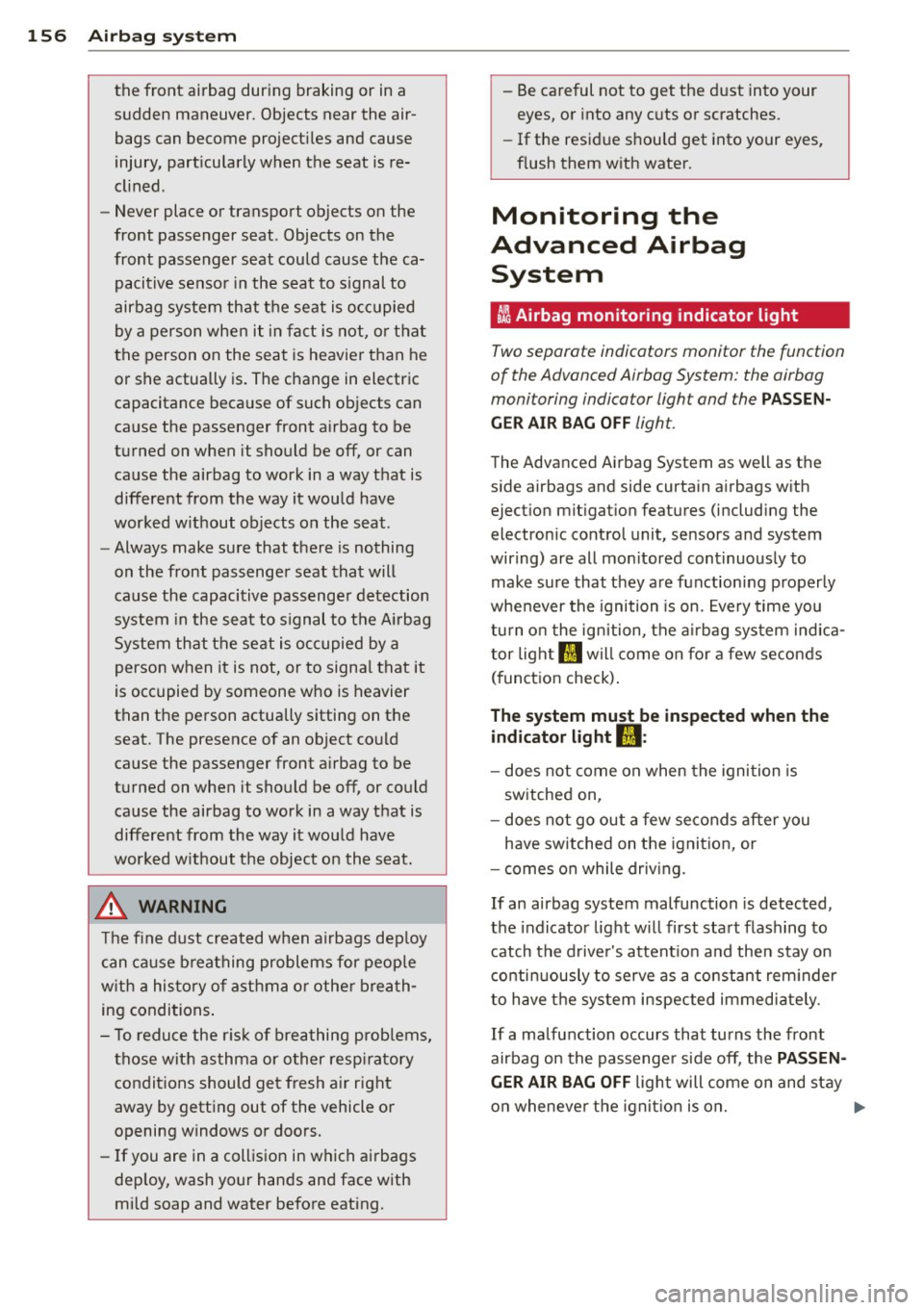
156 Airbag sys te m
the front airbag during braking or in a
sudden maneuver. Objects near the air
bags can become project iles and cause
injury, part icularly when the seat is re
cl ined.
- Never place or transport objects on the
front passenger seat . Objects on the
front passenger seat could cause the ca pacitive sensor in the seat to s ignal to
airbag system that t he seat is occupied
by a person when it in fa ct is not, o r that
the person on the seat is heavie r than he
or she actually is. The change in electric
capacitance because of such objects can
cause the passenger front a irbag to be
turned on when it sho uld be off, or can
cause the airbag to work in a way that is
different from the way it wou ld have
worked w ithout ob jects on the seat.
- Always make sure that there is nothing
on the front passenge r seat that will
cause the capacitive passenge r detection
sys tem in the seat to s ignal to t he A irbag
System th at the se at i s oc cupied by a
person when i t is not, or to signa l that it
is occupied by someone who is heavier
than the person actually sitting on t he
seat. The presence of an object co uld
cause the passenger front a irbag to be
turned on when it sho uld be off, or could
cause the airbag to work in a way that is
differe nt from the way it wou ld have
wor ked w ithout the object on the seat.
A WARNING
Th e fine dust created when a irbags dep loy
c an ca u se b reathing problems for peop le
w ith a his to ry o f asthma o r othe r bre at h
ing conditions .
- T o reduce the r is k of b reathing prob lems ,
those wit h asthma or o ther resp iratory
conditions should ge t fresh a ir r ight
away by gett ing out of the vehicle o r
opening windows or doo rs .
- If you are in a coll is ion in which ai rbags
deploy, wash your hands and face w ith
mild soap and water befo re eat ing. -
Be ca reful not to get the dust into your
eyes, or into any c uts or scratches.
- If the resid ue s hould get into your eyes,
f lush them w ith wate r.
Monitoring the
Advanced Airbag
System
tli Airbag monitor ing indicator light
Two separate indicators monitor the function
of the Advanced Airbag System: the airbag
monitoring indicator light and the
PASSEN
GER AIR BAG OFF
light.
The Advanced Airbag System as well as the
s ide airbags and side curta in a irbags w ith
eject ion mit igat ion features (including the
electron ic contro l unit, se nsors a nd system
wiring) are all mon itored continuously to
make su re that they are functioning p roperly
whenever the ignition is on. Eve ry time you
tu rn o n the ignition, the a irbag sys tem indica
tor light
II w ill come on fo r a few seconds
(funct ion check) .
The system must be inspected when the
indicator light
II:
- does not come on when the igni tion is
sw itched on,
- does not go out a few seconds after you
have switched on the ignit ion, or
- comes on while driv ing.
If an airbag system malfunction is detected,
the indicator lig ht w ill first sta rt flashing to
catch t he d rive r's attent io n and the n stay on
conti nuously to serve as a constant rem inder
to have the sys tem inspected immed iate ly.
If a malfunction occurs that tu rns the front
airbag on the passenge r side off, the
PASSEN
GER AIR BAG OFF
light will come on and stay
o n wheneve r th e ign it io n is on. .,..
Page 159 of 310
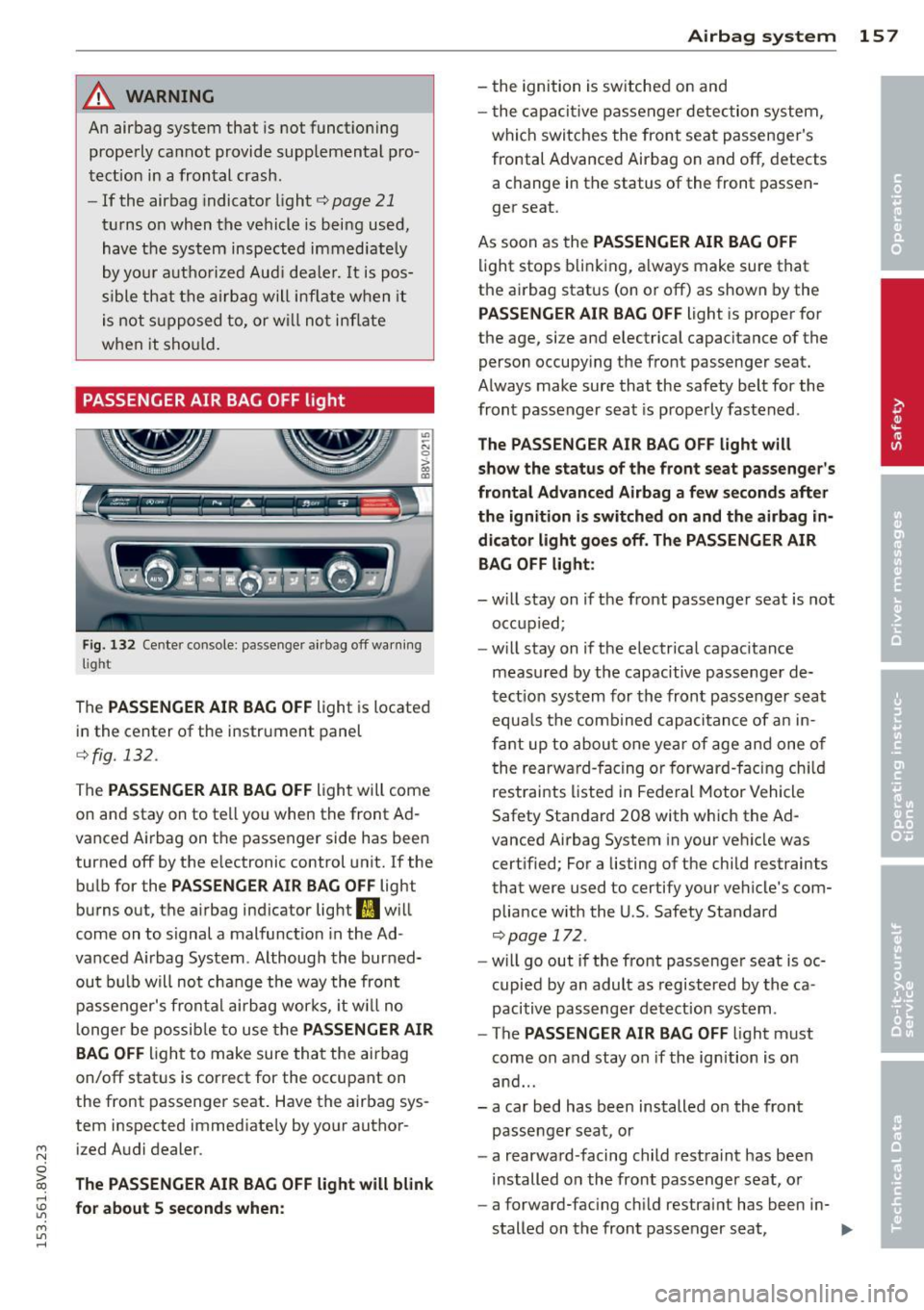
_& WARNING
An airbag system that is not functioning
properly cannot provide supplemental pro
tection in a frontal crash.
- If the airbag indicator light¢
page 21
turns on when the vehicle is being used,
have the system inspected immediately
by you r auth o riz ed Aud i dea le r. It is pos
sible that the airb ag will inf late when it
is not s upposed to, or w ill not inflate
when it sho uld .
PASSENGER AIR BAG OFF light
Fig. 13 2 Center console: passenger a irbag off warnin g
light
The PASSENGER AIR BAG OF F light is located
in the center of the instrument panel
¢fig. 132.
The PASSENGER AIR BAG OFF light will come
on and stay on to tell yo u when the front Ad
vanced A irbag on t he passenger side has been
turned off by the e lectronic control unit. If the
bulb for the
PASSENGER AIR BAG OFF light
burns out, the a irbag indicator light
fl w ill
come on to signal a malfunction in the Ad
vanced A irbag System . Although the bur ned
out b ulb will not cha nge the way the front
passenger's frontal airbag wor ks, it w ill no
l onge r be possib le to use the
PASSENGER AIR
BAG
OFF light to make sure that the airbag
on/off stat us is correct for the occupant on
the front passenger seat. Have the airbag sys
tem inspected immed iate ly by your author-
~ ized Audi dealer.
0
iii The PASSENGER AIR BAG OFF light will blink rl
:5: for about 5 seconds when :
M l/1 rl
Airba g sy stem 15 7
- the ignition is sw itched on and
- t he capaci tive passenger detec tion system,
which switches the front seat passenger's
frontal Advanced Airbag on and off, detects a change in the status of the front passen
ger seat.
As soon as the
PASSENGER AIR BAG OFF
light stops blink ing, a lways make sure that
the ai rbag status (on or off) as shown by the
PASSENGER AIR BAG OFF light is proper for
the age, size and electrical capacitance of the
person occupying the front passenger seat.
Always make sure that the safety belt for the
front passenger seat is properly fastened.
The PASSENGER AIR BAG OFF l ight will
show the status of the front sea t passenger 's
fronta l Advan ced Airbag a fe w se conds after
th e ignition i s sw itched on and th e airbag in
dicator light goes off. The PASSENGER AIR
BAG
OFF light :
- will stay on if the front passenger seat is not
occupied;
- will stay on if the electrical capacitance
meas ured by the capacitive passenge r de
tect io n system for the fron t passenger s eat
equa ls the comb ined capacitance of an in
fa nt up to about one year of age and one of
t he rearwa rd- facing or forward-fa cing ch ild
restraints listed in Fede ral Motor Vehicle
Safety Standard 208 with which the Ad
vanced Airbag System in your vehicle was
cert ified; For a listing of the child restraints
that were used to certify your vehicle's com
pliance w ith the U.S. Safety Standard
~page 172 .
-will go out if the fro nt passenge r seat is oc
cupied by an adult as registered by the ca
pacitive passenger detection system .
- The
PASSENGER AIR BAG OFF light must
come on and stay on if the ignition is on
and ...
- a car bed has been installed on the front passenger seat, or
- a rearwa rd-facing child rest ra int has been
installed on the front passenger seat, or
- a forward-facing child restrai nt has been in-
stalled on the front passenger seat, .,,.
Page 160 of 310
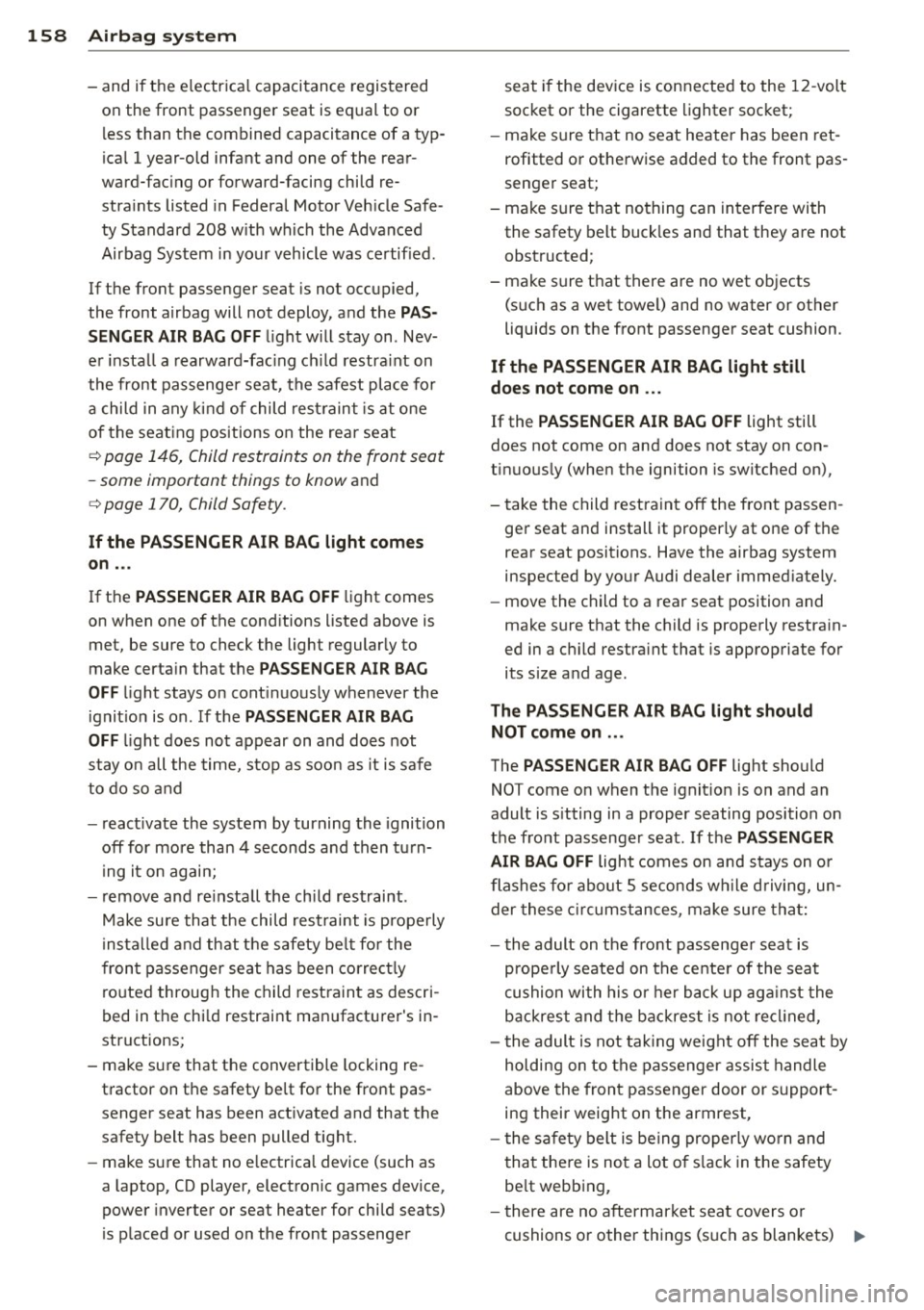
158 Airbag system
- and if the electrica l capacitance registered
on the front passenger seat is equal to or
l ess than the combined capacitance of a typ
ical 1 year-old infant and one of the rear
ward-facing or forward-facing child re
stra ints listed in Federal Motor Vehicle Safe
ty Standard 208 w ith which the Advanced
Airbag System in your vehicle was certified.
If the front passenger seat is not occupied,
the front airbag will not deploy, and the
PAS
SENGER AIR BAG OFF
light will stay on . Nev
er insta ll a rearward-facing child restraint on
the front passenger seat, the safest place for
a child in any kind of child restraint is at one
of the seat ing positions on the rear seat
¢ page 146, Child restraints on the front seat
- some important things to know
and
¢ page 170, Child Safety .
If the PASSENGER AIR BAG light comes
on ...
If the PASSENGER AIR BAG OFF light comes
on when one of the conditions listed above is met , be sure to check the light regularly to
make certa in that the
PASSENGER AIR BAG
OFF
light stays on cont inuously whenever the
ignit ion is on . If the
PASSENGER AIR BAG
OFF
l ight does not appear on and does not
stay on all the time, stop as soon as it is safe
to do so and
- reactivate the system by turning the ignition
off for more than 4 seconds and then turn
i ng it on again;
- remove and re install the child restraint.
Make su re that the child restraint is properly
installed and that the safety belt fo r the
front passenger seat has been correctly
routed through the child restraint as descri
bed in the chi ld restraint man ufacturer 's in
structions;
- make sure that the convertible locking re
tractor on the safety belt for the front pas
senger seat has been activated and that the
safety belt has been pulled tight.
- make sure that no e lectrica l device (such as
a laptop, CD playe r, electronic games device,
power inverter or seat hea ter for child seats)
is placed or used on the front passenger seat
if the device is connected to the 12-volt
socket or the cigarette lighter socket;
- ma ke sure that no seat heater has been ret
rofitted or otherwise added to the front pas
senger seat;
- make s ure that nothing can interfere with
the safety belt buck les and that they are not
obstructed ;
- make sure that there are no wet objects
(such as a wet towe l) and no water or other
liquids on the front passenger seat cushion.
If the PASSENGER AIR BAG light still
does not come on ...
If the PASSENGER AIR BAG OFF light still
does not come on and does not stay on con
tinuous ly (when the ignition is switched on),
- take the child restraint off the front passen -
ger seat and install it properly at one of the
rear seat positions. Have the airbag system
inspected by your Audi dealer immed iately.
- move the child to a rear seat position and
make sure that the child is properly restrain
ed in a ch ild restra int that is appropriate for
its size and age .
The PASSENGER AIR BAG light should
NOT come on ...
The PASSENGER AIR BAG OFF light should
NO T come on when the ignition is on and an
adult is s itting in a proper seating position on
the front passenger seat. If the
PASSENGER
AIR BAG OFF
light comes on and stays on or
flashes for about S seconds wh ile d riving, un
der these circumstances, make sure that:
- the adult on the front passenger seat is
properly seated on the cente r of the seat
cushion with his or her back up aga inst the
backrest and the backrest is not reclined,
- the adult is not taking weight off the seat by
holding on to the passenger assist handle
above the front passenger door or support
ing their weight on the armrest ,
- t he safety belt is being properly wo rn and
that there is not a lot of s lack in the safety
be lt webbing,
- there are no aftermarket seat covers or
cushions or other things (such as blankets) .,..